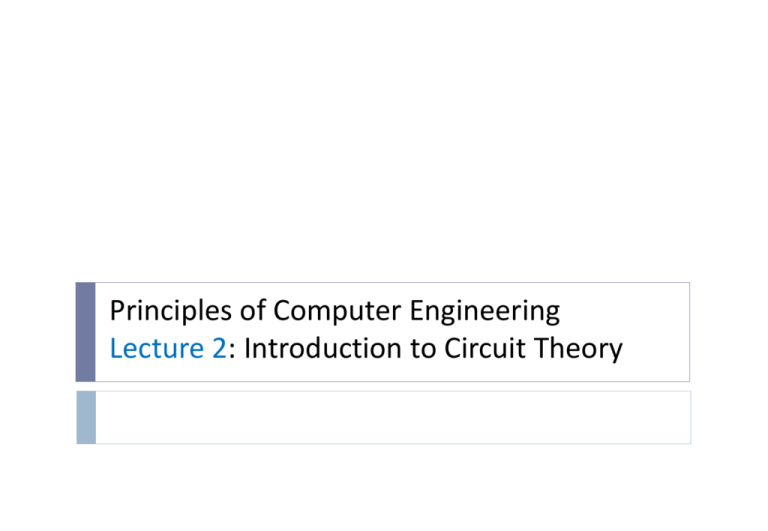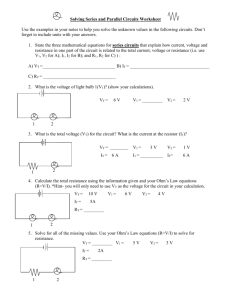Week-2
advertisement

Principles of Computer Engineering Lecture 2: Introduction to Circuit Theory Charge, Voltage & Current Electric Charge, e = 1.6 x 10-19 Coulombs (one electron) The separation of charge gives rise to electric force, voltage (also called Potential Difference) The flow of charge gives rise to electric current Voltage = Rate of change of Energy per unit charge (Coulomb) 1 V = 1 Joule/coulomb Current = Rate of change of Charge per unit time (second) 1 A = 1 coulomb/second v = voltage (Volts) E = Energy or w = work (Joules) q = charge (Coulombs) t = time (seconds) Both voltage and current have direction or polarity Passive Sign Convention “Basic Ideal Circuit Element” ‘Basic’ → cannot be reduced ‘Ideal’ → non-realisable Passive Sign Convention Current is considered to be the flow of ‘positive’ charge. [In reality negative electrons flow]. (a) For an element which is a ‘consumer’, current flows into the positive terminal to negative. P is positive. (b) For a generator (power supply), conventions states that the power produced, P, is negative. Power and Energy 1 Watt = 1 Joule per second. Convention: current flowing in the opposite direction to the flow of electrons. 1 A =1000 mA = 1,000,000 μA 1 μA = 10-3 mA = 10-6 A 1mA = 10-3 A Independent Voltage & Current Sources An independent voltage source (a) can maintain the fixed voltage independent of the load An independent current source (b) must maintain its specific current flow at all times Valid Circuits? Ohm’s Law Resistance is the capacity of materials to impede (obstruct, block) the flow of electric current. Ohm’s Law: v = iR v : [Volts] i : [Amps] R : [Ohms or ‘Ω’] Power measured in Watts (W) v v 2 P vi (iR )i i R v R R 2 Combining Series Resistors vs is R1 is R2 is R3 is R4 is R5 is R6 is R7 vs is ( R1 R2 R3 R4 R5 R6 R7 ) vs Req R1 R2 R3 R4 R5 R6 R7 is Combining Parallel Resistors vs i1 R1 i2 R2 i3 R3 i4 R4 is i1 i2 i3 i4 1 vs vs vs vs 1 1 1 is vs R1 R2 R3 R4 R1 R2 R3 R4 is 1 1 1 1 1 vs Req R1 R2 R3 R4 Voltage Divider Circuit vs i ( R1 R2 ) v1 iR1 v2 iR2 vs v1 R1 R1 R2 R1 v1 vs R1 R2 R2 v2 vs R1 R2 Current Divider Circuit v i1 R1 i2 R2 v is Requiv R1 R2 i1 R1 is R1 R2 R1 R2 Requiv R1 R2 R2 i1 is R1 R2 R1 & i2 is R1 R2 Summary Introduced simple circuit theory Concepts of charge, voltage and current Passive sign convention, flow of conventional current Concept of power dissipation Potential and current dividers Questions? Principles of Computer Engineering: Experiment 2: Ohm’s Law & Power Overview Introduction to Ohm’s Law and Power dissipation Read resistor codes and tolerance values Build simple to test potential and current dividers Appreciate component tolerances and measurement errors Resistors Colour Codes Procedure 1: Ohm’s Law & Power Build circuit pictured Measure current for different values of resistor Calculate power dissipation Draw graph to show power vs. resistance A Procedure 2: Voltage Divider Build circuit pictured Measure voltage for different values of resistance R2 Calculate theoretical value of V2 across R2 𝑉2 = 𝑅2 𝑉𝑠 𝑅1 +𝑅2 =10*1/2 = 5v and 7.5, 9, 9.5V. Compare with measured values for four different R2 Lab manual P30 table 2 R1 [] ±___% R2 [] ±___% set VR2 [V] ±___% measurements Theoretical VR2 [V] 𝑉𝑅2 = 𝑉𝑠 1000 1000 5 1000 3000 7.5 1000 9000 9 1000 19000 9.5 𝑅2 𝑅1 + 𝑅2 Procedure 3: Current Divider Build circuit pictured Measure current for different values of resistance R2 Calculate theoretical value of I2 through R2 Compare with measured values for four different R2 NB: Must calculate equivalent resistance and source current A Lab manual P31 table 2 R1 [] ±__% R2 [] ±__% set 1000 1000 1000 3000 1000 9000 1000 19000 Rtotal [] ±__% R1||R2 = R1*R2/(R1+R2) Is [mA] ±__% IR2 [mA] ±__% Theory IR2 [mA] Is = 10v/Rtotal measurements 𝐼𝑅2 𝑅1 = 𝐼𝑠 𝑅1 + 𝑅2 R1 [] ±__% R2 [] ±__% set Rtotal [] ±__% R1||R2 = R1*R2/(R1+R2) Is [mA] ±__% IR2 [mA] ±__% Theory IR2 [mA] Is = 10v/Rtotal measurements 𝐼𝑅2 𝑅1 = 𝐼𝑠 𝑅1 + 𝑅2 1000 1000 500 20 10 1000 3000 750 13.33 3.3 1000 9000 900 11.1 1.1 1000 19000 950 10.5 0.52 Summary Become familiar with Ohm’s Law and resistor colour codes Build elementary circuits to determine power dissipation Verify via practical experimentation the theory behind voltage and current dividers Appreciate error margins and component tolerances Questions?






